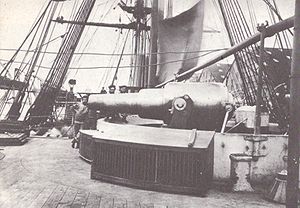HMS Temeraire (1876)
| 50x40px | This article includes a list of references, related reading or external links, but its sources remain unclear because it lacks inline citations. Please improve this article by introducing more precise citations where appropriate. (April 2009) |
| HMS Temeraire | |
| Career | |
|---|---|
| Name: | HMS Temeraire |
| Builder: | Chatham Dockyard |
| Laid down: | 18 August 1873 |
| Launched: | 9 May 1876 |
| Completed: | 31 August 1877 |
| Fate: | Broken up, 1921 |
| General characteristics | |
| Type: | Battleship |
| Displacement: | 8,540 long tons (8,677 t) |
| Length: | 285 ft (87 m) |
| Beam: | 62 ft (19 m) |
| Draught: | 27 ft 6 in (8.38 m) |
| Propulsion: |
Two-shaft Humphreys & Tennant compound vertical inverted 7,697 ihp (5,740 kW) |
| Sail plan: | Brig-rigged, sail area 25,000 sq ft (2,300 m2) |
| Speed: | 14.65 knots (16.86 mph; 27.13 km/h) |
| Complement: | 580 |
| Armament: |
• 4 × 11-inch (280 mm) muzzle-loading rifles |
| Armour: |
Belt: 5.5–11 in (140–280 mm) Barbettes: 10-inch (250 mm) fore, 8 in (200 mm) aft Battery: 8 in (200 mm) Bulkheads: 5–8 in (130–200 mm) Deck: 1–1.5 in (25–38 mm) |
HMS Temeraire was an ironclad battleship of the Victorian Royal Navy which was unique in that she carried her main armament partly in the traditional broadside battery, and partly in barbettes on the upper deck.
Design and construction

She was built at Chatham, on a slipway adjoining that on which HMS Alexandra, who would precede her into service by some seven months, was being built. She was designed at a time when the shortcomings of the traditional broadside battery - limited axial fire, low command, inactivity of half the guns in single-ship duels, heavy crew and difficulty in working the guns in seaway - were stimulating designers to develop improvements in artillery deployment.
Her armament was partly conventional, being deployed on the broadside, and partly experimental; she was the first British ship to be equipped with guns in barbettes located on the midline on the upper deck. Indeed, she was the first British ship with barbettes of any kind. The foremost barbette was located ahead of the foremast, and had a field of fire ahead, extending to well abaft the beam on both sides. To achieve the same degree of freedom of fire from the after barbette the mizzen mast was deleted, and the after barbette placed aft of the mainmast. Temeraire and Alexandra were the only British battleships ever to carry guns of 11-inch (280 mm) calibre.
The design of the barbettes was itself unique, being the one of the few ships to have been equipped with disappearing guns. On firing, the recoil of the gun caused it to drop below deck level; this allowed re-loading without the exposure of the gun crew to aimed enemy fire. After loading, the gun was rotated by a hydraulic system back into the firing position. While this system was effective, it was slow and expensive and was never repeated.
The suppression of the mizzen mast resulted in Temeraire being the largest ship ever to sail with brig rig, that is, with sail carried on only two masts. She was known during her life as "the Great Brig".
Service history
She was commissioned at Chatham in 1877 for service in the Mediterranean, where she spent the next fourteen years with the exception of the winter of 1887-1888, when she was with the Channel Fleet. She was with Admiral Geoffrey Hornby through the Dardanelles in 1878, and remained in the vicinity of Constantinople for a year thereafter. After recommissioning at Malta in 1881 she was present at the bombardment of Alexandria (1882), firing 136 11-inch (280 mm) shells and 84 10-inch (250 mm). She paid off at Portsmouth in 1887, and then returned to the Mediterranean for her final three years of active service. On 3 October 1890 HMS Temeraire became the last ship of the Royal Navy to stand into harbour under sail alone at Suda Bay, Crete. With her crew handling sails and sheets, just as they had done under Nelson, Anson, Rodney and Howe, the fleet watched as she took five hours to slowly beat into harbour. HMS Temeraire was paid off at Devonport in 1891.
She was in the Reserve Fleet until 1893, when she was downgraded to Fleet Reserve. She was dockyard Reserve in 1901, and in 1904 became part of the Indus stoker training establishment, and was renamed Indus II. In 1915, under the new name of Akbar, she was transferred to Liverpool as a reformatory ship. During the First World War she served as a depot ship, and was finally sold 26 May 1921.
See also
References
- Oscar Parkes British Battleships ISBN 0-85052-604-3
- Roger Chesneau and Eugene M. Kolesnik, ed., Conway's All The Worlds Fighting Ships, 1860-1905, (Conway Maritime Press, London, 1979), ISBN 0-85177-133-5
- Dittmar F. J. & Colledge J. J., "British Warships 1914-1919, (Ian Allen, London,1972) ISBN 0-7110-0380-7
External links
| HMS Temeraire (1876)
]]
